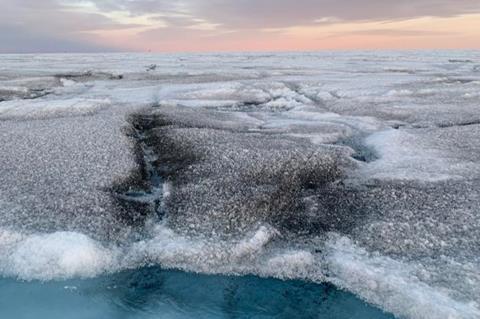Every spring when the sun rises in the Arctic after months of darkness, life returns. Algae lying dormant on the ice starts blooming in spring, blackening large areas of the ice.

When the ice blackens, its ability to reflect the sun diminishes and this accelerates the melting of the ice. Increased melting exacerbates global warming.
But researchers might have found a way to control the snow algae growth – and maybe in the long run reduce some of the ice from melting. Living on the ice alongside the algae, postdoc Laura Perini from the Department of Environmental Science at Aarhus University and her colleagues, have found giant viruses.
Control mechanism
She suspects that the viruses feed on the snow algae and could work as a natural control mechanism on the algae blooms.
”We don’t know a lot about the viruses, but I think they could be useful as a way of alleviating ice melting caused by algal blooms. How specific they are and how efficient it would be, we do not know yet. But by exploring them further, we hope to answer some of those questions,” she says.
Giant viruses were first discovered in 1981, when researchers found them in the ocean. These viruses had specialized in infecting green algae in the sea. Later, giant viruses were found in soil on land and even in humans.
But it’s the first time that giant viruses have been found living on the surface ice and snow dominated by microalgae, Laura Perini explains.
Dark ice and red snow
”We analyzed samples from dark ice, red snow and melting holes (cryoconite). In both the dark ice and red snow we found signatures of active giant viruses. And that is the first time they’ve been found on surface ice and snow containing a high abundance of pigmented microalgae.
A few years ago everyone thought this part of the world to be barren and devoid of life. But today we know that several microorganisms live there – including the giant viruses.
”There’s a whole ecosystem surrounding the algae. Besides bacteria, filamentous fungi and yeasts, there are protists eating the algae, different species of fungi parasitizing them and the giant viruses that we found, infecting them.
“In order to understand the biological controls acting on the algal blooms, we need to study these last three groups.”
Naked eye
Even though the viruses are giant, they can’t be seen with the naked eye. Laura Perini hasn’t even seen them with a light microscope yet. But she hopes to do so in the future.
”The way we discovered the viruses was by analyzing all the DNA in the samples we took. By sifting through this huge dataset looking for specific marker genes, we found sequences that have high similarity to known giant viruses,” she explains.
To make sure that the viral DNA didn’t come from long dead microorganisms, but from living and active viruses, they also extracted all the mRNA from the sample.
When the sequences of the DNA that form genes are activated, they are transcribed into single stranded pieces called mRNA. These pieces work as recipes for building the proteins the virus needs. If they are present the virus is alive.
”In the total mRNA sequenced from the samples, we found the same markers as in the total DNA, so we know they have been transcribed. It means that the viruses are living and active on the ice,” she says.
Active genes
Because giant viruses are a relatively new discovery not a lot is known about them. In contrast to most other viruses they have a lot of active genes that enable them to repair, replicate, transcribe and translate DNA.
But why that is and exactly what they use it for is not known.
”Which hosts the giant viruses infect, we can’t link exactly. Some of them may be infecting protists while others attack the snow algae. We simply can’t be sure yet,” Laura Perini says.
She’s working hard on discovering more about the giant viruses and has more research coming out soon.
”We keep studying the giant viruses to learn more about their interactions and what is exactly is their role in the ecosystem. Later this year we’ll release another scientific with some more info on giant viruses infecting a cultivated microalgae thriving on the surface ice of the Greenland Ice Sheet,” she concludes.







No comments yet